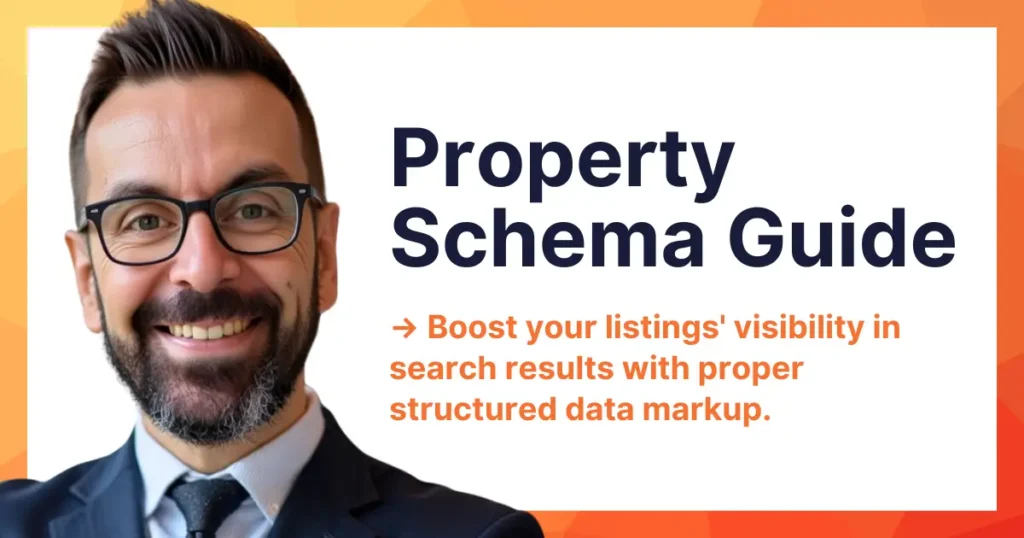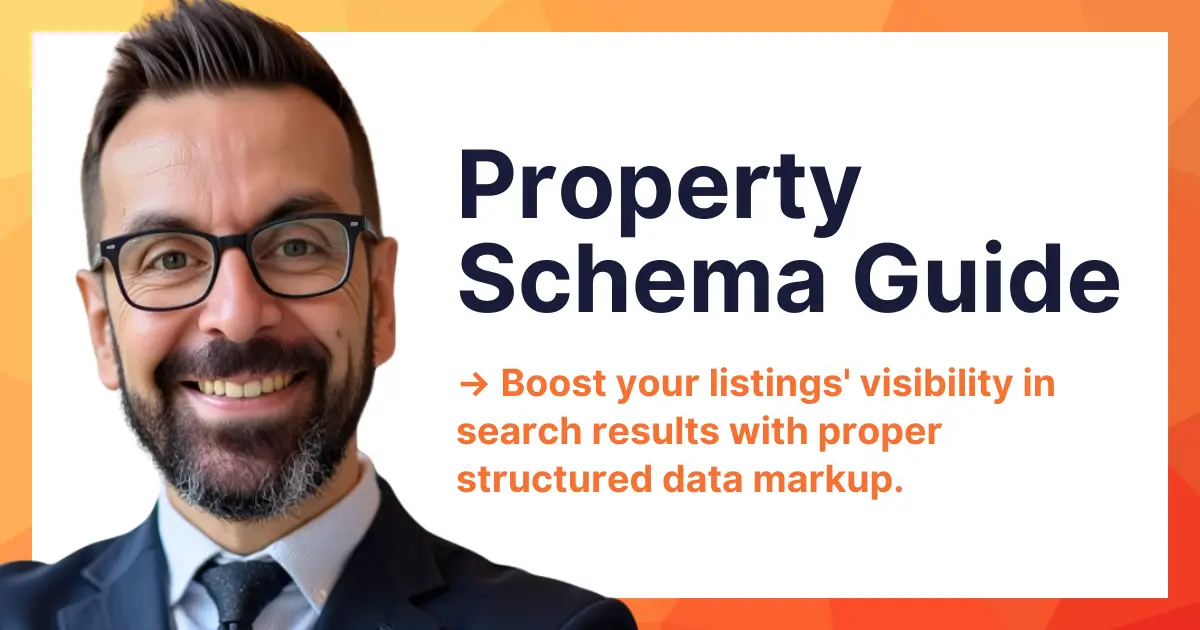Real estate has always been about location… Except now, the prime real estate you need to dominate is the search engine results page (SERP). With high competition and people turning to the internet for virtual tours, online open houses, and property research, you need every advantage you can get. Real estate schema markup is one of the most effective tools you can use to help search engines better understand your website’s content, which can lead to improved visibility, higher click-through rates, and ultimately more leads.
In this guide, you’ll discover exactly how schema markup works, why it matters for your real estate business, and how to implement it on your site. You’ll also find actionable tips, code examples, and best practices to keep you ahead of the game. Let’s see why schema markup is too important to ignore in today’s fast-paced, digital-first real estate landscape.
Understanding Real Estate Schema Markup
To fully embrace real estate schema markup, you need an understanding of what schema markup is and how it helps your website. In this section, you’ll learn the basic concepts of schema markup, what structured data is all about, and why the real estate sector needs specialized types of structured data.
What Is Schema Markup?
Schema markup is a standardized format of structured data that you add to your website’s code. It’s like a translator between your content and search engines, helping them understand not just the text on your pages but the actual meaning behind that text. Instead of leaving Google or Bing to guess whether your listing is a condo, a single-family residence, or a local business address, schema markup makes it explicit.
Schema markup can come in different formats (Microdata, RDFa, or JSON-LD) but most webmasters prefer JSON-LD. It’s easier to maintain, you can place it anywhere on your webpage (often in the head section), and it’s endorsed by Google. When you label your property listings, open house dates, agent profiles, and contact details with the correct tags from schema.org, you give search engines a crystal-clear understanding of every aspect of your real estate business.
Schema Markup vs. Structured Data
You’ll sometimes hear “schema markup” and “structured data” used interchangeably. Structured data is the overarching concept of organizing data (in this case, your real estate information) in a structured way. Schema markup is a specific vocabulary and approach, led by Google, Bing, Yahoo, and Yandex collectively, to make sure that structured data is uniform across the web. For real estate, schema markup is the secret sauce that ties everything together, from address details to event times for open houses.
Why It Matters in Real Estate
People searching for homes have countless options. They’ll typically type something like “3-bedroom house for sale in Los Angeles” or “best real estate agent near me,” and if your site isn’t optimized, you’ll miss out on valuable traffic. With schema markup, you can highlight key details (like the price range, number of bedrooms, square footage, and open house schedule) directly on the SERP. This extra information can make your listing more eye-catching, boosting click-through rates and ensuring potential clients don’t scroll past your site.
You now know the fundamentals of schema markup and why it’s a necessity for real estate websites. In the next section, you’ll discover the most important reasons to use schema markup, including specific benefits like enhanced local SEO and improved lead conversions. So get ready: understanding the “why” behind schema markup is what powers effective implementation.
Why Schema Markup Matters for Real Estate Websites
When you’re marketing property listings online, proper data structures can mean the difference between minimal visibility and a stream of qualified leads.
1. Boosted Search Engine Visibility and Rankings
Search engines rely heavily on context to figure out which search results best answer a user’s query. When you’re using real estate schema markup, you’re handing Google or Bing a well-labeled package of information. This clarity often translates into higher organic rankings because search engines don’t have to guess what’s on your site. You’re also better prepared for next-generation search improvements (like Google’s “Project Magi,” rumored to leverage deeper contextual data), which reward sites that supply complete and structured data.
2. Higher Click-Through Rates (CTR)
Have you ever seen SERP results with star ratings, pricing details, or quick FAQs? That’s the power of structured data at work. For real estate, your results can display property prices, open house schedules, or even a mini FAQ. This additional, relevant information draws the eye and gives searchers confidence that your site matches what they’re seeking. As a result, they’re more likely to click on your listings than on a generic result.
3. Enhanced Lead Generation
When people click through to a listing with robust property details, they’re often warmer leads. Why? Because they found exactly what they wanted to see. If your search snippet already showed a property’s price, location, and property type, a user who wants that property is more likely to request a showing or make a call. That means a smoother sales funnel for you, as visitors enter your site with a specific interest in mind.
4. Local SEO Advantage
Real estate is all about serving clients in specific neighborhoods or cities. Using schema markup for your business details, such as your office address, phone number, and hours, you show up more reliably in local search results. This is especially crucial for agents or brokerages focusing on local niches. Google can connect your business to a particular geographic area, increasing your chances of appearing in the coveted local pack and Google Maps results.
5. Better Engagement with Multimedia
Virtual tours and video walkthroughs are huge in real estate. Video markup can signal to search engines that your page includes a video for a property tour. This can lead to richer previews in search results, a unique thumbnail, or even a labeled “virtual tour” tag. The result is a more engaging listing that resonates with today’s digitally savvy homebuyers.
Schema markup doesn’t just help search engines; it helps you showcase your real estate expertise in a more visible, attractive way. Next, let’s explore the key schema markup types most relevant to real estate so you can implement them effectively on your site.
Key Real Estate Schema Markup Types
In real estate, not all schema markup is created equal. Different schema types cater to different aspects of the home-buying or property-search experience. Below, you’ll find three of the most essential schema types to consider. Each one includes a brief explanation of why it’s beneficial, so you can pick the right structure for your listings, open houses, or local business details.
3 Critical Schema Markup Types for Real Estate
- RealEstateListing
This type is specifically tailored for leasing or selling property. It covers broad listing details like the date the property was posted, the lease length (if any), and property type. It’s perfect for big portals or brokerage sites that have multiple properties on offer. - LocalBusiness (RealEstateAgent)
If you run a real estate agency or you’re an agent yourself, the LocalBusiness or RealEstateAgent schema helps highlight your contact information, address, operating hours, and social media pages. This is a powerful way to establish your local presence and ensure your business stands out in city-specific or region-specific searches. - Event
In real estate, “events” often mean open houses or 3D property tours. Using the Event schema, you can display the upcoming date, time slots, and possibly even a link to register for a visit, all within search results. This convenience can drive more foot traffic and increase the likelihood of a sale.
Filling the Gaps with Other Useful Types
Real estate is a multifaceted industry, so you might need more than the three schemas above to cover all your listings:
- SingleFamilyResidence
The SingleFamilyResidence schema builds on the House schema and is perfect for emphasizing the number of rooms, year built, or whether pets are allowed. - Person
If you’re an individual agent, you can use the Person schema with a RealEstateAgent subtype to highlight your job title, the brokerage you work for, and direct contact links. - Video
If you have virtual tours, add the Video markup so that search engines know your page features a video. This can result in eye-catching previews and a higher chance of engagement. - FAQPage
Many real estate sites feature a Q&A section covering mortgage basics, neighborhood details, or closing procedures. Marking these answers up with FAQ schema can display questions and answers directly in the SERP.
Using the right schema for the right content is essential. RealEstateListing is a great starting point for property details, but you’ll often need additional schema types to fully capture what your site has to offer. Up next, you’ll discover a step-by-step approach to implementing these various schemas, complete with practical tips and helpful tools.
Step-by-Step: How to Implement Schema Markup
Implementation can feel intimidating if you’re not a developer, but you don’t need extensive coding experience to add structured data to your site. In this section, you’ll learn a straightforward, repeatable process for adding schema markup to any real estate webpage.
Step 1: Select the Right Schema Type
Start by identifying what you want to highlight. Are you showcasing a brand-new property listing? Consider RealEstateListing or SingleFamilyResidence. Do you want to promote upcoming open houses? Use the Event schema. Once you know your goal, explore the relevant schema type at schema.org to see which properties are required and which are optional.
Step 2: Generate or Hand-Code Your Markup
You can write the JSON-LD code yourself if you’re comfortable with HTML, or you can use a schema generator tool like Google’s Markup Helper, Merkle, or SearchBloom. For instance, to add a FAQ schema to a page about home financing, you’d open the schema generator, choose “FAQ Page,” and fill in the questions and answers. A real estate agent might do the same with a RealEstateAgent markup, adding business hours, phone number, and social media links.
Step 3: Embed and Test the Code
After generating your JSON-LD, embed it in the head section of your webpage’s HTML. If you’re using a CMS, paste it into a designated area for scripts. Test it right away with Google’s Rich Results Test or the schema.org validator. Look for any warnings or errors, fix them, then retest until you get the green light.
Congratulations! You’ve taken the core steps to implement schema markup on your real estate site. You chose the appropriate schema type, created valid JSON-LD code, and verified its accuracy, so you set the stage for better visibility and user engagement. In the next section, you’ll pick up valuable tips to avoid common pitfalls, so your site stays fully optimized.
Common Pitfalls and Best Practices
Even the most thorough plan can run into hiccups. Real estate websites juggle property descriptions, open house events, local business info, and more, so it’s easy to inadvertently mix up schema types or duplicate content. In this section, you’ll learn about the most common mistakes and what you can do to prevent them. You’ll also walk away with tips to keep your markup clean, consistent, and compliant with search engine guidelines.
Potential Pitfalls
It’s important to steer clear of pitfalls that can derail your schema strategy. Here are two frequent problems:
- Overlapping Schema
You might be tempted to use multiple schemas describing the same feature. For example, using both “House” and “SingleFamilyResidence” on the same property can create confusion if the data isn’t consistent. Choose one relevant subtype and ensure your details align. - Incorrect or Incomplete Data
If you include property details in your schema that don’t actually appear on the page, like listing a different price than what your visitors see, you could trigger red flags with search engines. Always make sure the information in your markup reflects the content visible to users.
3 Best Practices for Ongoing Success
- Validate Often
Use validation tools regularly, especially if you’re adding new listings, hosting special events, or updating business hours. - Keep Content Fresh
When property listings change, remember to update your schema. Search engines love fresh, accurate data. - Test and Monitor
Watch your click-through rates and engagement metrics. If something dips, verify that your schema is still valid and relevant.
Staying aware of these pitfalls and adhering to best practices ensures your real estate schema markup maintains its value over time. Just by updating data frequently and validating your code, you’ll stay on search engines’ good side and remain a reliable source of information for buyers. Finally, let’s wrap up all these insights and explore how your business can truly maximize the benefits of schema markup.
Conclusion: Putting It All into Action
You’ve learned the fundamentals of real estate schema markup, the specific types most relevant to agents and brokerages, and the step-by-step approach to implementing and testing. By now, you should have a clear roadmap for transforming your real estate site into a structured data powerhouse that search engines love.
Final Thoughts and Next Steps
Schema markup is more than just technical jargon. It’s a practical, results-driven approach to modern real estate marketing. Whether you’re highlighting open houses, featuring a new listing with a video tour, or simply making sure your office’s contact details are clear, schema markup helps you stand out in a crowded digital marketplace.
You don’t have to add every schema type at once. Take small, consistent steps:
- Identify the key pages or listings that need better visibility.
- Generate relevant JSON-LD.
- Validate the data and watch how your site performs.
When you provide search engines with clear, detailed information about your properties, services, and events, you set yourself up for better search performance and more qualified leads. Real estate schema markup may seem technical at first, but it’s a straightforward process once you grasp the basics.
Now is the time to implement these strategies so you can reap the benefits of improved visibility, higher engagement, and the potential for more closed deals. Go ahead, put real estate schema markup into action and watch your online presence flourish. Or… you can contact a real estate SEO consultant like me to do it for you!
You can learn more with these articles:














